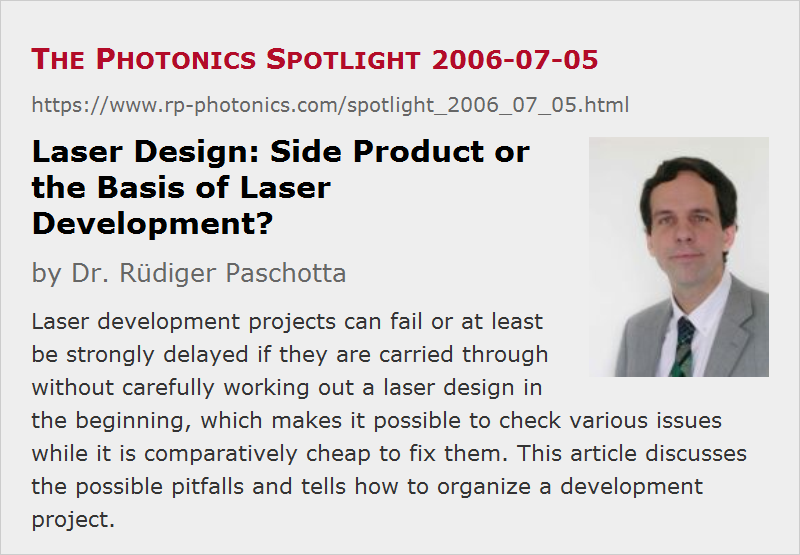Laser Design: Side Product or the Basis of Laser Development?
Posted on 2006-07-05 (revised on 2007-03-16) as a part of the Photonics Spotlight (available as e-mail newsletter!)
Permanent link: https://www.rp-photonics.com/spotlight_2006_07_05.html
Author: Dr. Rüdiger Paschotta, RP Photonics Consulting GmbH
Abstract: Laser development projects can fail or at least be strongly delayed if they are carried through without carefully working out a laser design in the beginning, which makes it possible to check various issues while it is comparatively cheap to fix them. This article discusses the possible pitfalls and tells how to organize a development project.

Ref.: encyclopedia articles on laser development and laser design
Everyone has heard about such laser development projects which develop into a nightmare, with nasty unexpected problems, requiring measures which cure one problem while exacerbating another one, finally leading to time-consuming revisions, so that the market entry is delayed further and further. The resulting costs are enormous: not only spending many additional man months and keeping the costly infrastructure occupied with that project, but also delaying the time where the product brings revenue, apart from losing the waiting customers' confidence. In the worst case, a competitor uses the time to get his product placed …
The origin of such problems is probably very often related to the role attributed to laser design within the laser development. Laser design appears frequently to be considered as a kind of side product of the development work, perhaps just written up some time after the actual development; the work itself is based on some degree of experience, some reasonable principles (e.g. trying it out step by step), but to some significant extent also on trial and error.
The cure is then to redefine the role of laser design to support the lab work rather than just to somehow result from it. Obviously, for that purpose it has to be developed first – not in the lab, but on the desk. This involves quantitative checks of the central issues; not necessarily full-blown numerical modeling, but at least a number of relatively simple calculations e.g. concerning the required pump and laser intensities, the laser gain and optimum output coupler transmission, the balance of pulse-shaping effects (in a mode-locked laser), etc. When problems are identified at this stage, they will often not require more than a few hours to be solved. In the lab, this process is much more costly: it is often far more difficult to correctly diagnose a problem there, and more tedious to try out various measures.
The deliverable of the laser design work is a clear design report, to be discussed with all the involved engineers. Of course, there can still be unexpected problems, but the likelihood of significant delays can be strongly reduced with proper preparations.
Particularly in smaller laser companies, there are plenty of possible reasons why resources are wasted by engaging in prototype building without being properly prepared:
- the lack of an internal expert with sufficient physics knowledge and experience,
- the cost of getting an external laser expert to do (or check) the design work (even though this is nearly negligible compared with the damage of a nightmare project as described above),
- the anxiety to keep the expertise in house (even though few things may push the in-house expertise as much as reading and discussing good design reports),
- and certain psychological barriers preventing people from learning from disastrous experience. (Interestingly, some people prefer to “explain” the phenomenon with “Murphy's law”, “that's life”, etc., rather than doing something about it!)
But be assured that the really successful laser companies have learned to deal with these obstacles and are always making sure that an experienced expert – whether in house or hired as a consultant – takes care of the critical design stages from the beginning.
See the above referenced encyclopedia articles for more details. Besides, there is a related Spotlight article on the issue of time to market.
This article is a posting of the Photonics Spotlight, authored by Dr. Rüdiger Paschotta. You may link to this page and cite it, because its location is permanent. See also the RP Photonics Encyclopedia.
Note that you can also receive the articles in the form of a newsletter or with an RSS feed.
Questions and Comments from Users
Here you can submit questions and comments. As far as they get accepted by the author, they will appear above this paragraph together with the author’s answer. The author will decide on acceptance based on certain criteria. Essentially, the issue must be of sufficiently broad interest.
Please do not enter personal data here; we would otherwise delete it soon. (See also our privacy declaration.) If you wish to receive personal feedback or consultancy from the author, please contact him e.g. via e-mail.
By submitting the information, you give your consent to the potential publication of your inputs on our website according to our rules. (If you later retract your consent, we will delete those inputs.) As your inputs are first reviewed by the author, they may be published with some delay.
 |




If you like this page, please share the link with your friends and colleagues, e.g. via social media:
These sharing buttons are implemented in a privacy-friendly way!